Optimal Scheduling of Zero-Carbon Parks Considering Flexible Response of Source–Load Bilaterals in Multiple Timescales
Abstract
:1. Introduction
2. Zero-Carbon Park Structure Based on Energy Hubs
2.1. Structure of the Park
2.2. Characterization of Energy Flows in Energy Hubs
2.3. Energy Hub Modeling Considering Carbon Potential Distribution
3. Source–Load Bilateral Flexible Response Model and Operation Mechanism
3.1. Equipment Model
3.1.1. Modeling of Equipment Operation in Variable Conditions
3.1.2. Flexible Operation Model for Carbon Capture Devices
3.2. Load Response Modeling
3.2.1. PDR Model Considering Carbon Potential Correction
3.2.2. IDR Model Considering Different Response Rates
3.2.3. TCL Model Considering Heat Transfer in Buildings
3.3. Source–Load Flexible Dual-Response Mechanism and Scheduling Framework
4. Multi-Timescale Low-Carbon Scheduling Modeling
4.1. Day-Ahead Scheduling Optimization Model
4.1.1. Objective Function
4.1.2. Constraints
- Power balance constraints:where denotes the power sold in the park; denotes the power generated by KLN; denotes the electric power of conventional loads; , , and denote the electric power of building base loads, resilient loads, and incentivized loads; and denote the heat/cooling power output from GSHP; and denote the heat power of building base loads and temperature-controlled loads; denotes the cooling power output from XHL; and and denote the cooling power of building base loads and temperature-controlled loads.
- Interactive power constraints with the higher grid/gas grid:where and denote the maximum power purchased/sold by the park to the higher grid; denotes the status of power purchased/sold by the park to the higher grid; and denotes the maximum amount of gas purchased by the park to the natural gas grid.
- PV output constraints:
- Equipment output limits and climbing constraints [41]:where and indicate the upper and lower limits of the output of the equipment ; and indicate the upper and lower limits of the climb of the equipment .
- Energy storage device constraints [42]:where denotes the energy stored at time t; denotes the energy self-depletion rate; and denote the charging and discharging state variables of the energy storage at ; and denote the maximum charging and discharging power of the energy storage; and denote the upper and lower limits of the energy storage capacity; and and denote the energy storage capacity of the initial moment and the final moment, which are balanced in a dispatching cycle.
4.1.3. Processing of Movement Control Results
4.2. Intraday Scheduling Optimization Model
4.2.1. Objective Function
4.2.2. Constraints
4.2.3. Processing of Movement Control Results
4.3. Real-Time Scheduling Optimization Model
4.3.1. Objective Function
4.3.2. Constraints
4.3.3. Processing of Movement Control Results
4.4. Solution Flow
5. Example Analysis
5.1. Basic Parameter Settings
5.2. Analysis of the Results of the Previous Day’s Scheduling
- The power supply of the park is supported by the higher grid, natural gas, and PV, with priority given to PV and the purchase of power from the higher grid when the price of electricity is low. Since PV is easily affected by light conditions, PV only supplies power to the park from 7 to 19 h. The rest of the time, the park is maintained by the higher grid and CHP. The KLN can not only recover electricity from flue gas waste heat, but can also absorb excess heat energy from CHP to generate electricity, which improves energy utilization efficiency. The energy storage device has a small capacity and only comes out when the unit’s ramp-up is restricted. The CCS operating in a flexible mode consumes more electrical energy during the 1–6 h period when the electricity price is low and the 8–16 h period when the PV is sufficient, separating CO2 and sequestering it.
- The elastic electrical load of the building is strongly influenced by the electricity price, and mainly focuses on the 1~6 h and 14~19 h large amount of electricity consumption when the electricity price is lower or when the PV is sufficient. After the introduction of carbon potential correction coefficient, the resulting corrected tariff does not violate the peak and valley time division of time-sharing tariff on the overall trend, but on its benchmark, through the adjustment of the planned carbon potential and correction coefficient; the carbon potential changes brought about by the change of the energy composition structure are transmitted to the load side by the tariff signal. The load side, by changing its own electricity consumption hours, in turn affects the supply-side output, which in turn changes the energy composition structure and realizes the source–load synergistic interaction, with price curves and carbon potential curves as shown in Figure A2 in Appendix A. The building incentive electric loads are mainly concentrated in the period of 1~6 h when the price of electricity is lower and the period of 7~19 h when the PV is sufficient to use a large amount of electricity, which not only optimizes the operational burden of the park during the peak period, but also reduces the level of carbon emissions in the park.
- The heat supply of the park is supported by both CHP and GSHP, with priority given to the use of CHP to meet the heat demand, and shortfalls in heat made up by GSHP. XHL consumes a large amount of thermal energy to meet cooling demand. The building temperature control heat load flexibly adjusts its own heat use period in 1~6 h, 9 h, and 24 h, according to the actual indoor comfort requirement.
- The cold energy supply of the park is jointly supported by XHL and GSHP, with priority given to the use of XHL to meet the cold demand and the shortfall in cold energy made up by GSHP. The temperature-controlled cold load of the building is flexibly adjusted to its own cold period in 8 h and 11~23 h, according to the actual indoor comfort requirements.
5.3. Analysis of the Results of Different Scenarios
5.4. Analysis of Operational Results Under Different Carbon Trading Mechanism Parameters
6. Conclusions
- In order to improve the park’s low-carbon economic benefits, a multi-temporal scheduling model is constructed that takes into account the response characteristics of flexibility resources and regulates source–load fluctuations. This approach is consistent with the operation of a zero-carbon park under source–load coordination and electricity–carbon coupling.
- The unit’s variable operating conditions, integrated demand response on the load side, and stepped carbon trading mechanism are all taken into account by the model in this paper, which fully utilizes the source–load coordination capability, increases the unit’s flexibility in operating under various loads and environmental conditions, and aids in the system’s more accurate controlling of carbon emissions.
- The scheduling outcomes of the system will be affected by various carbon trading characteristics. In addition, the scheduling model’s high degree of accuracy allows for more precise evaluation and optimization of the system’s scheduling strategy, which in turn enables the integration of renewable energy sources into demand response, lessens reliance on conventional energy sources, and produces a more precise and effective low-carbon operation.
Author Contributions
Funding
Data Availability Statement
Conflicts of Interest
Appendix A
| Price Type | Time Interval | Parameters/(USD kW−1) |
|---|---|---|
| Time-of-use tariff | 01:00–06:00 | 0.5 |
| 07:00–13:00, 20:00–24:00 | 1.21 | |
| 14:00–19:00 | 0.73 | |
| Fixed purchase/sale price of electricity | 01:00–24:00 | 0.8, 0.45 |
| Fixed purchase price of gas | 01:00–24:00 | 3.5 |
| Installations | Parameter Name | Parameter Value |
|---|---|---|
| PV unit | O&M cost per unit of power | (USD kW−1) |
| Penalty cost per unit of power abandoned | (USD kW−1) | |
| CHP unit | Generation efficiency | |
| O&M cost per unit of power | (USD kW−1) | |
| Upper and lower limits of power generation/kW | ||
| Maximum heat production power | kW | |
| Power generation at maximum heat production | kW | |
| Upper and lower slopes | ||
| Start–sbottom costs | USD | |
| Climbing upper and lower limits | ||
| KLN unit | Generation efficiency | |
| Maximum power | kW | |
| O&M cost per unit of power | (USD kW−1) | |
| Lithium bromide unit | Cooling efficiency | |
| O&M cost per unit of power | (USD kW−1) | |
| GSHP unit | Heating/cooling efficiency | |
| Maximum heating/cooling power/kW | ||
| O&M cost per unit of power | (USD kW−1) | |
| Carbon capture unit | Energy consumption factor | |
| Maximum power consumption | kW | |
| Upper and lower limits of trapping efficiency | ||
| O&M cost per unit of power | (USD kW−1) | |
| Climbing upper and lower limits | ||
| ES unit | Charge and discharge efficiency | |
| self-depletion rate | ||
| O&M cost per unit of power | (USD kW−1) | |
| Maximum charge/discharge power/kW | ||
| Capacity upper and lower limits/kW | ||
| Initial capacity/kW |
| Parameter Name | Parameter Value |
|---|---|
| Effective area of vegetation/km2 | |
| Maximum power purchased and sold to the higher grid/kW | |
| Maximum purchase of gas from the natural gas grid/cubic meter | |
| IDR load minimum response/kW | |
| IDR load unit power compensation cost/(USD-kW−1) | |
| Ideal room temperature/°C | |
| Minimum permissible indoor comfort | |
| Temperature controlled load compensation cost/(USD-kW−1) | |
| Direct heat transfer coefficient of building facades | |
| Heat transfer coefficient of internal walls of buildings | |
| Heat/cold energy and temperature conversion factor/(kW-°C−1) | |
| Coal/natural gas carbon emission factor/(kgCO2-kW−1) | |
| Coal electric/thermal energy baseline factor/(kgCO2-kW−1) |
| Section | PV/% | Carbon Credits | CEL/% | BFEL/% | BREL/% | BIEL/% | BFHL/% | BFCL/% | Room Temperature/% |
| Day-ahead | 20 | 20 | 3 | 5 | 5 | 5 | 5 | 5 | 5 |
| Intraday | 5 | 5 | 1 | 3 | 3 | 3 | 3 | 3 | 3 |
| Real-time | 2 | 2 | 0.5 | 1 | 1 | 1 | 1 | 1 | 1 |
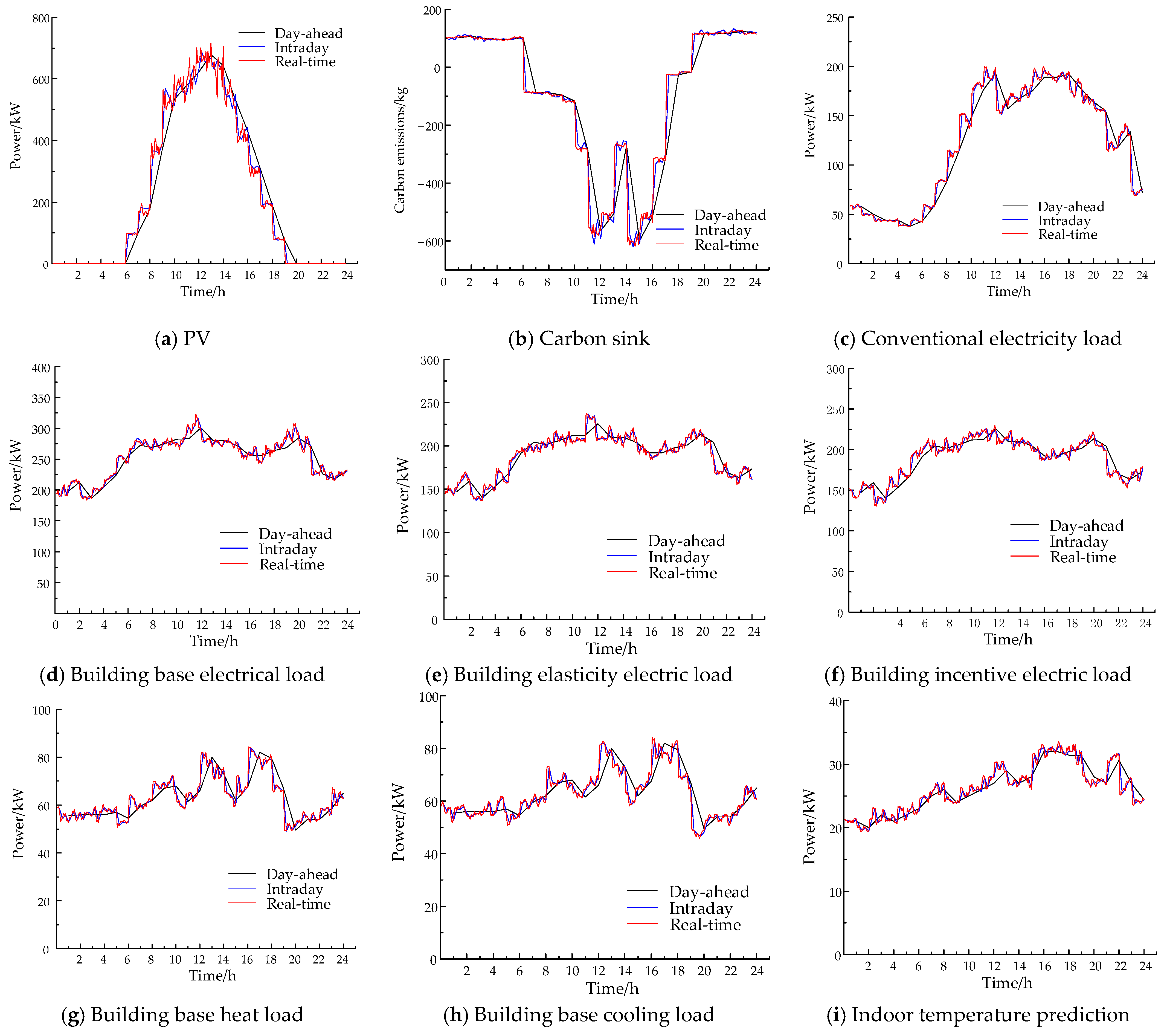



References
- Zhang, N.; Li, Z.; Zheng, X.; Liu, P. How Would Structural Change in Electricity and Hydrogen End Use Impact Low-Carbon Transition of an Energy System? A Case Study of China. Processes 2024, 12, 437. [Google Scholar] [CrossRef]
- Long, X.; Liu, H.; Wu, T.; Ma, T. Optimal Scheduling of Source–Load Synergy in Rural Integrated Energy Systems Considering Complementary Biogas–Wind–Solar Utilization. Energies 2024, 17, 3066. [Google Scholar] [CrossRef]
- Liu, G.; Wang, J.; Tang, Y. Evolution of research direction and application requirements of carbon emission factors in power grids. Grid Technol. 2024, 48, 12–28. [Google Scholar]
- Meng, Q.; Zu, G.; Ge, L.; Li, S.; Xu, L.; Wang, R.; He, K.; Jin, S. Dispatching Strategy for Low-Carbon Flexible Operation of Park-Level Integrated Energy System. Appl. Sci. 2022, 12, 12309. [Google Scholar] [CrossRef]
- Yang, Z.; Wang, X. Research on Low-Carbon Capability Evaluation Model of City Regional Integrated Energy System under Energy Market Environment. Processes 2022, 10, 1906. [Google Scholar] [CrossRef]
- Li, Z.; Deng, F.; Zhu, Q.; Cao, L.; Jiang, Y. Do the Chinese Government’s Efforts to Make a Low-Carbon Industrial Transition Hinder or Promote the Economic Development? Evidence from Low-Carbon Industrial Parks Pilot Policy. Sustainability 2023, 15, 77. [Google Scholar] [CrossRef]
- Zhang, J.; Liu, D.; Lyu, L.; Zhang, L.; Du, H.; Luan, H.; Zheng, L. Multi-Time-Scale Low-Carbon Economic Dispatch Method for Virtual Power Plants Considering Pumped Storage Coordination. Energies 2024, 17, 2348. [Google Scholar] [CrossRef]
- Hua, P.; Wang, H.; Xie, Z.; Lahdelma, R. Integrated demand response method for heating multiple rooms based on fuzzy logic considering dynamic price. Energy 2024, 307, 132577. [Google Scholar] [CrossRef]
- Le, S.; Zhang, Y.; Zhu, S.; Xie, S. Configuration-operation co-optimization of coal-fired power plants with carbon capture considering low-carbon demand response. Power Autom. Equip. 2024, 44, 278–286. [Google Scholar]
- Wang, C.; Lu, Z.; Li, Y.; Zhang, J.; Kong, X. A collaborative planning approach for urban integrated energy systems considering hybrid energy storage and demand response. High Volt. Technol. 2024; in press. [Google Scholar]
- Xia, R.; Dai, J.; Cheng, X.; Fan, J.; Ye, J.; Jia, Q.; Chen, S.; Zhang, Q. Demand Response of Integrated Zero-Carbon Power Plant: Model and Method. Energies 2024, 17, 3431. [Google Scholar] [CrossRef]
- Ma, L.; Li, X.; Kong, X.; Yang, C.; Chen, L. Optimal participation and cost allocation of shared energy storage considering customer directrix load demand response. J. Energy Storage 2024, 81, 110404. [Google Scholar] [CrossRef]
- Mugnini, A.; Ramallo-González, A.P.; Parreño, A.; Molina-Garcia, A.; Skarmeta, A.F.; Arteconi, A. Dynamic building thermal mass clustering for energy flexibility assessment: An application to demand response events. Energy Build. 2024, 308, 114011. [Google Scholar] [CrossRef]
- Li, Y.; Han, M.; Yang, Z.; Li, G. Coordinating flexible demand response and renewable uncertainties for scheduling of community integrated energy systems with an electric vehicle charging station: A bi-level approach. IEEE Trans. Sustain. Energy 2021, 12, 2321–2331. [Google Scholar] [CrossRef]
- Zhu, D.; Chen, W.; Guo, X.; Yin, X.; Liu, D. Hybrid time-scale scheduling strategy for wind power consumption by thermal storage electric heating and demand response. Chin. J. Electr. Eng. 2024; in press. [Google Scholar]
- Li, X.; Zhang, R.; Bai, L.; Li, G.; Jiang, T.; Chen, H. Stochastic low-carbon scheduling with carbon capture power plants and coupon-based demand response. Appl. Energy 2018, 210, 1219–1228. [Google Scholar] [CrossRef]
- Li, L.; Fan, S.; Xiao, J.; Zhou, H.; Shen, Y.; He, G. Fair trading strategy in multi-energy systems considering design optimization and demand response based on consumer psychology. Energy 2024, 306, 132393. [Google Scholar] [CrossRef]
- Cheng, M.; Niu, W.; Hu, J.; Wang, Z.; Chen, J.; Lin, C. Construction mode optimal selection method for intelligent sensing system in zero-carbon parks. J. Eng. 2023, 2023, e12326. [Google Scholar] [CrossRef]
- Hu, Y.; Xie, T.; Chi, N.; Yang, Y. Design of energy big data and carbon emission monitoring system based on perceptron model in the context of carbon neutral and carbon peaking. Appl. Math. Nonlinear Sci. 2024, 9. [Google Scholar] [CrossRef]
- Zahedmanesh, A.; Verbic, G.; Rajarathnam, G.; Weihs, G.F.; Shikata, K.; Matsuda, N.; Abbas, A. Optimal design of greenfield energy hubs in the context of carbon neutral energy supply. Energy 2024, 305, 132284. [Google Scholar] [CrossRef]
- Asano, H.; Ishii, H.; Takano, H. Distributed Energy Resource Integration for Carbon Neutral Power Systems: Market-Based Approaches to Ancillary Services and Microgrid Operation. IEEJ Trans. Electr. Electron. Eng. 2024, 19, 598–607. [Google Scholar] [CrossRef]
- Wang, L.; Zhang, S.; Fu, Y.; Liu, M.; Liu, J.; Yan, J. Heat–power decoupling for the CHP unit by utilizing heat storage in the district heating system integrated with heat pumps: Dynamic modeling and performance analysis. Energy 2024, 306, 132485. [Google Scholar] [CrossRef]
- Ding, X.; Yang, Z.; Zheng, X.; Zhang, H.; Sun, W. Effect of decision-making principle on P2G–CCS–CHP complementary energy system based on IGDT considering energy uncertainty. Int. J. Hydrogen Energy 2024, 81, 986–1002. [Google Scholar] [CrossRef]
- Liu, X. Multiple time-scale economic dispatching strategy for commercial building with virtual energy storage under demand response mechanism. Int. J. Energy Res. 2021, 45, 16204–16227. [Google Scholar] [CrossRef]
- Wang, L.; Ren, X.; Ma, Y.; Liu, Z.; Dong, W.; Ni, L. Optimal low-carbon scheduling of integrated energy systems considering stepped carbon trading and source-load side resources. Energy Rep. 2024, 12, 3145–3154. [Google Scholar] [CrossRef]
- Yan, X.; Wang, L.; Fang, M.; Hu, J. How Can Industrial Parks Achieve Carbon Neutrality? Literature Review and Research Prospect Based on the CiteSpace Knowledge Map. Sustainability 2023, 15, 372. [Google Scholar] [CrossRef]
- Feng, J.; Yan, J.; Yu, Z.; Zeng, X.; Xu, W. Case study of an industrial park toward zero carbon emission. Appl. Energy 2018, 209, 65–78. [Google Scholar] [CrossRef]
- Cheng, J.; Wang, L.; Pan, T. Optimized configuration of distributed power generation based on multi-stakeholder and energy storage synergy. IEEE Access 2023, 11, 129773–129787. [Google Scholar] [CrossRef]
- Cheng, Y.; Zhang, N.; Wang, Y.; Yang, J.; Kang, C. Modeling carbon emission flow in multiple energy systems. IEEE Trans. Smart Grid 2018, 10, 3562–3574. [Google Scholar] [CrossRef]
- Xu, D.; Xiang, S.; Bai, Z.; Wei, J.; Gao, M. Optimal multi-energy portfolio towards zero carbon data center buildings in the presence of proactive demand response programs. Appl. Energy 2023, 350, 121806. [Google Scholar] [CrossRef]
- Chu, X.; Fu, L.; Liu, Q.; Yu, S. Optimal allocation method of oxygen enriched combustion-carbon capture low-carbon integrated energy system considering uncertainty of carbon-source-load. Int. J. Electr. Power Energy Syst. 2024, 162, 110220. [Google Scholar] [CrossRef]
- Li, J.; Xu, L.; Zhang, Y.; Kou, Y.; Liang, W.; Bieerke, A.; Yuan, Z. Economic Dispatch of Integrated Energy Systems Considering Wind–Photovoltaic Uncertainty and Efficient Utilization of Electrolyzer Thermal Energy. Processes 2024, 12, 1627. [Google Scholar] [CrossRef]
- Ramezani, R.; Di Felice, L.; Gallucci, F. A review on hollow fiber membrane contactors for carbon capture: Recent advances and future challenges. Processes 2022, 10, 2103. [Google Scholar] [CrossRef]
- Zhang, X.; Chen, S.; Wei, Z.; Liang, Z. Low-carbon planning of integrated energy systems in parks taking into account generalized energy storage. Power Autom. Equip. 2024, 44, 40–48. [Google Scholar]
- Zhao, H.; Miao, S.; Li, C.; Zhang, D.; Tu, Q. Optimized operation strategy of integrated energy system in a park considering coupled response characteristics of cooling, heating and power demand. Chin. J. Electr. Eng. 2022, 42, 573–589. [Google Scholar]
- Li, M.; Meng, X.; Wang, J.; Qi, C.; Ji, X.; Wang, H. Optimal Scheduling Strategy of Park Integrated Energy System Considering Ladder Carbon Trading Mechanism and Demand Response. In Proceedings of the 2023 8th Asia Conference on Power and Electrical Engineering (ACPEE), Tianjin, China, 14–16 April 2023; pp. 1390–1394. [Google Scholar]
- Liang, T.; Chai, L.; Tan, J. Dynamic optimization of an integrated energy system with carbon capture and power-to-gas interconnection: A deep reinforcement learning-based scheduling strategy. Appl. Energy 2024, 367, 123390. [Google Scholar] [CrossRef]
- Cai, F.; Wen, Z.; Jia, X. Multi-Time Scale Low-Carbon Optimization of IES Considering Demand Response of Multi-Energy. In Proceedings of the 2022 IEEE Conference on Telecommunications, Optics and Computer Science (TOCS), Dalian, China, 11–12 December 2022; pp. 793–799. [Google Scholar]
- Zhu, G.; Gao, Y. Multi-objective optimal scheduling of an integrated energy system under the multi-time scale ladder-type carbon trading mechanism. J. Clean. Prod. 2023, 417, 137922. [Google Scholar] [CrossRef]
- Dai, R.; Zhang, X.; Zou, H. Two-Stage Distributed Robust Optimal Allocation of Integrated Energy Systems under Carbon Trading Mechanism. Processes 2024, 12, 1044. [Google Scholar] [CrossRef]
- Xie, T.; Wang, Q.; Zhang, G.; Zhang, K.; Li, H. Low-Carbon Economic Dispatch of Virtual Power Plant Considering Hydrogen Energy Storage and Tiered Carbon Trading in Multiple Scenarios. Processes 2024, 12, 90. [Google Scholar] [CrossRef]
- Cao, W.; Yu, J.; Xu, M. Optimization Scheduling of Virtual Power Plants Considering Source-Load Coordinated Operation and Wind–Solar Uncertainty. Processes 2024, 12, 11. [Google Scholar] [CrossRef]
- Wu, M.; Xu, J.; Li, Y.; Zeng, L.; Shi, Z.; Liu, Y. Low carbon economic dispatch of integrated energy systems considering life cycle assessment and risk cost. Int. J. Electr. Power Energy Syst. 2023, 153, 109287. [Google Scholar] [CrossRef]
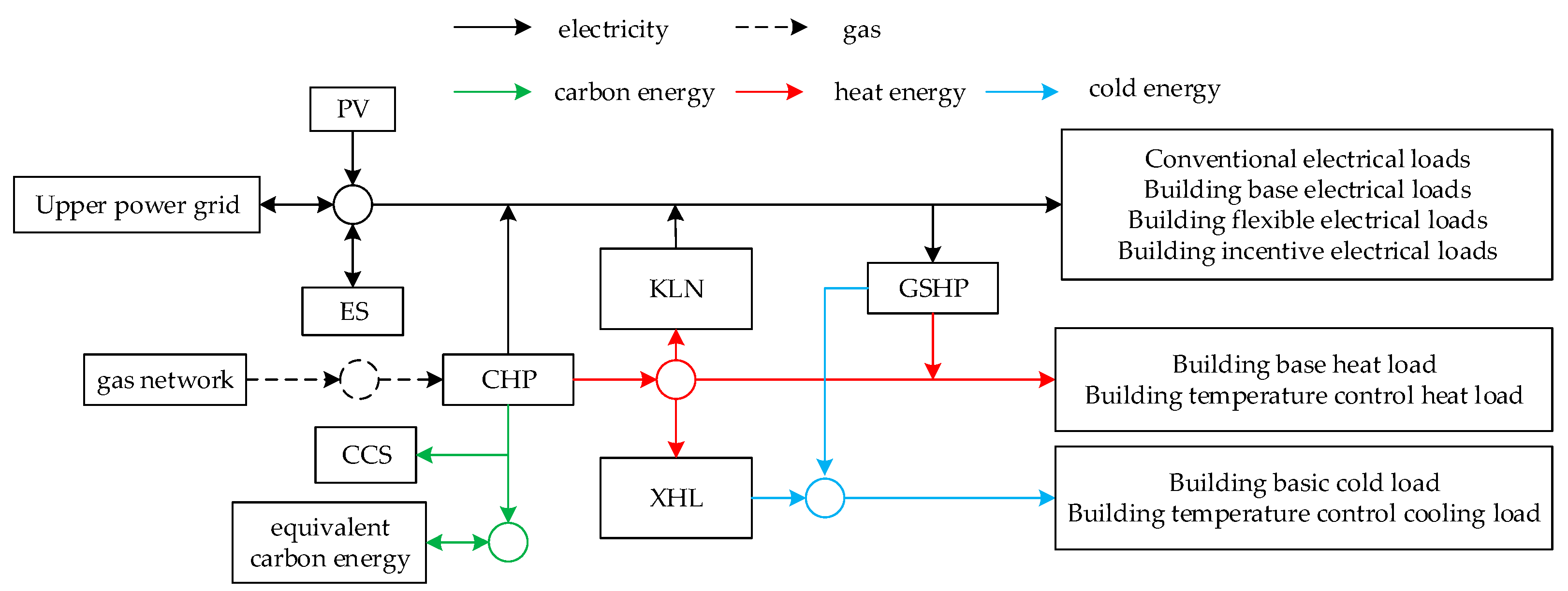

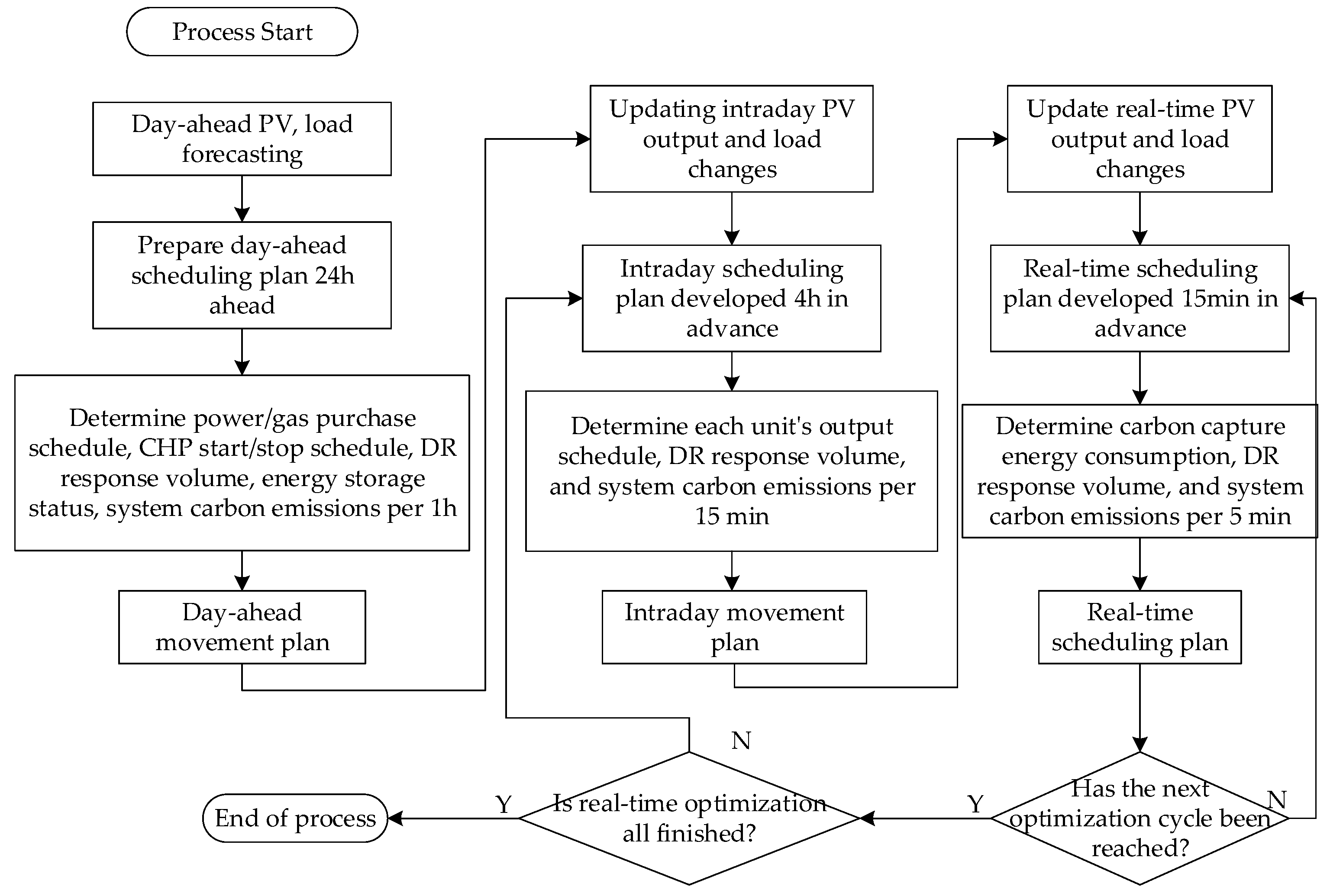

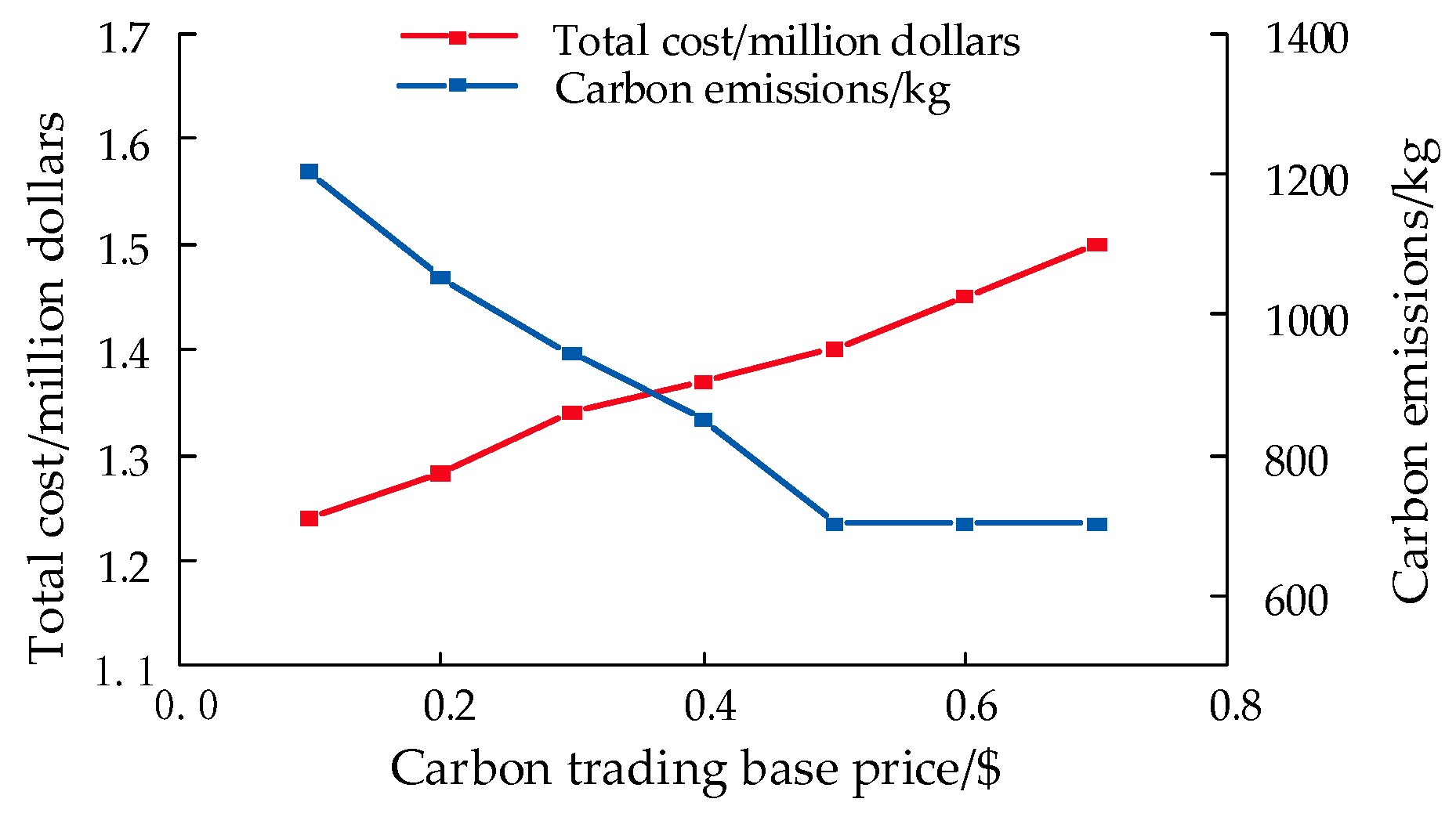

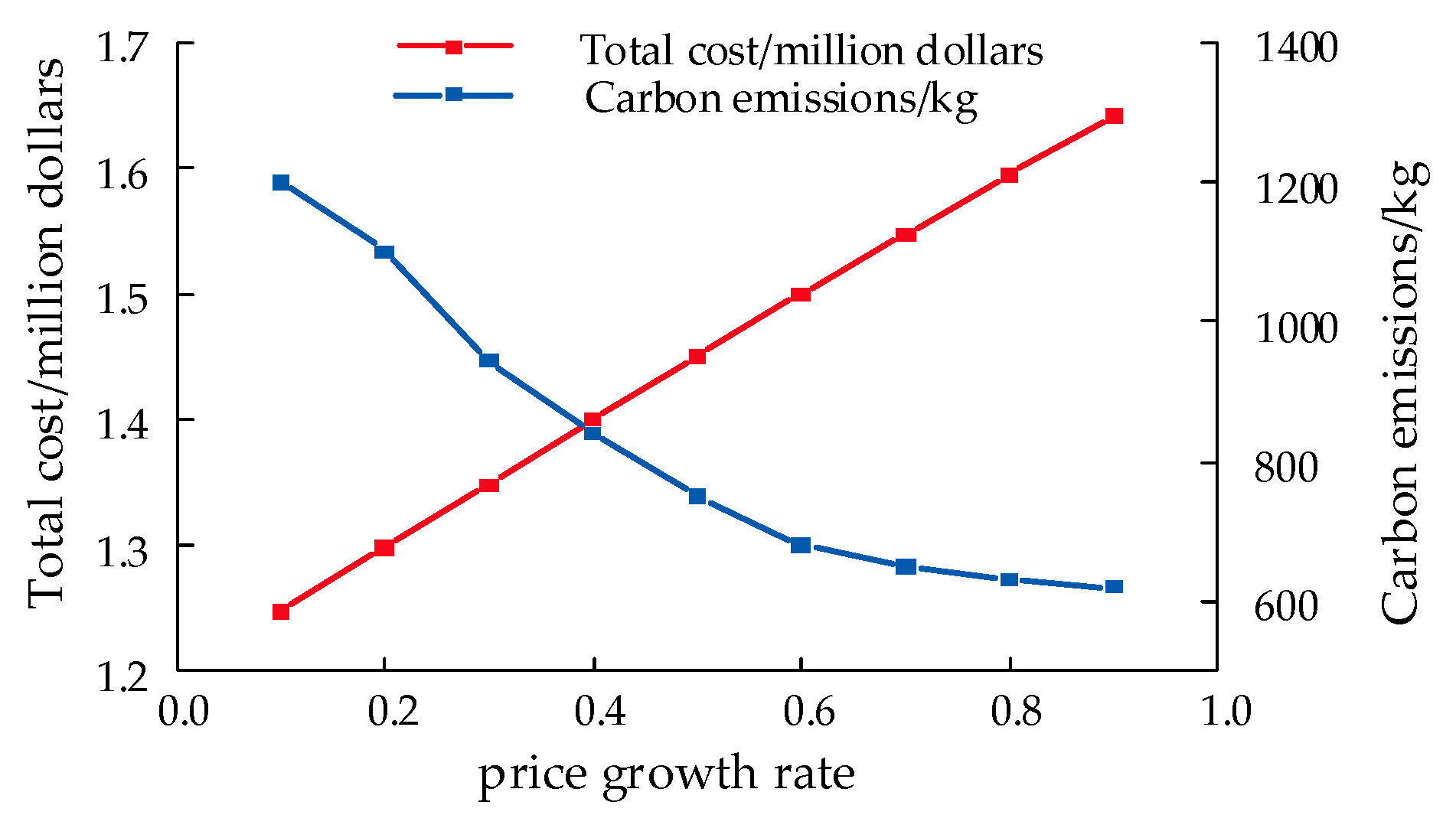
| Parameters | Scene 1 | Scene 2 | Scene 3 | Scene 4 |
|---|---|---|---|---|
| CRP/USD | 12,802 | 12,125 | 11,035 | 10,620 |
| CSS/USD | 350 | 0 | 0 | 0 |
| COM/USD | 1306 | 1284 | 1031 | 1023 |
| CCT/USD | / | / | / | 1075 |
| CCUR/USD | 205 | 157 | 45 | 0 |
| CIDR/USD | / | / | 322 | 330 |
| total cost/USD | 14,663 | 13,566 | 12,433 | 13,048 |
| carbon emissions/kg | 1597 | 1542 | 1305 | 995 |
Disclaimer/Publisher’s Note: The statements, opinions and data contained in all publications are solely those of the individual author(s) and contributor(s) and not of MDPI and/or the editor(s). MDPI and/or the editor(s) disclaim responsibility for any injury to people or property resulting from any ideas, methods, instructions or products referred to in the content. |
© 2024 by the authors. Licensee MDPI, Basel, Switzerland. This article is an open access article distributed under the terms and conditions of the Creative Commons Attribution (CC BY) license (https://creativecommons.org/licenses/by/4.0/).
Share and Cite
Wang, F.; Wang, W. Optimal Scheduling of Zero-Carbon Parks Considering Flexible Response of Source–Load Bilaterals in Multiple Timescales. Processes 2024, 12, 2850. https://doi.org/10.3390/pr12122850
Wang F, Wang W. Optimal Scheduling of Zero-Carbon Parks Considering Flexible Response of Source–Load Bilaterals in Multiple Timescales. Processes. 2024; 12(12):2850. https://doi.org/10.3390/pr12122850
Chicago/Turabian StyleWang, Fuyu, and Weiqing Wang. 2024. "Optimal Scheduling of Zero-Carbon Parks Considering Flexible Response of Source–Load Bilaterals in Multiple Timescales" Processes 12, no. 12: 2850. https://doi.org/10.3390/pr12122850
APA StyleWang, F., & Wang, W. (2024). Optimal Scheduling of Zero-Carbon Parks Considering Flexible Response of Source–Load Bilaterals in Multiple Timescales. Processes, 12(12), 2850. https://doi.org/10.3390/pr12122850






